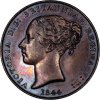barbquebutt
Active Member
Hey all,
I've looked through all of the existing threads I can find about casting coins, different techniques and methods and whatnot. What I want to ask specifically is what product would be best for what I have in mind.
I want to create a replica necklace that belongs to the character Jacob in the upcoming Assassin's Creed Syndicate game. References I can find lead me to believe is is an 1844 Victoria shilling coin.


The character appears to have punched a hole in the top, and mounted it on a leather string. I've found 1844 shillings on eBay for reasonable prices, but I don't want to destroy the original by drilling into it if I don't have to.
So I'm wondering what would be best to cast the coin in. Obviously pewter or other metal would be the preferred material, but being that it would be my first time working with metal casting, I don't know if this would be the best route. My other thought would be resin, but I don't know how resilient it would be as a necklace, since it would obviously have to be painted and would be more subject to wear and tear. Painting would also diminish the finer details, particularly on the back.
What do you all think? Is it worth the time and effort trying to cast in metal with no prior experience? Or should I stick with something a little more familiar like resin?
Thanks!
I've looked through all of the existing threads I can find about casting coins, different techniques and methods and whatnot. What I want to ask specifically is what product would be best for what I have in mind.
I want to create a replica necklace that belongs to the character Jacob in the upcoming Assassin's Creed Syndicate game. References I can find lead me to believe is is an 1844 Victoria shilling coin.


The character appears to have punched a hole in the top, and mounted it on a leather string. I've found 1844 shillings on eBay for reasonable prices, but I don't want to destroy the original by drilling into it if I don't have to.
So I'm wondering what would be best to cast the coin in. Obviously pewter or other metal would be the preferred material, but being that it would be my first time working with metal casting, I don't know if this would be the best route. My other thought would be resin, but I don't know how resilient it would be as a necklace, since it would obviously have to be painted and would be more subject to wear and tear. Painting would also diminish the finer details, particularly on the back.
What do you all think? Is it worth the time and effort trying to cast in metal with no prior experience? Or should I stick with something a little more familiar like resin?
Thanks!
Last edited:


